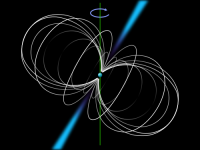Malintent
Veteran Member
Spacecraft is aware of its own velocity and can account for that and in fact that's how they determine velocity actually.Wouldn't the relative speed of the vessel affect the apparent frequency of the pulses? Thus making a specific pulsar harder to identify? Possibly that's why one needs multiple pulsars.
Oh, oh, oh.. I know, I know... how to be a dick... Spacecraft have self-awareness now? I guess the spacecraft thinks, "gee, I sure am going pretty fast. I better think about how fast I'm going..." Dick.

